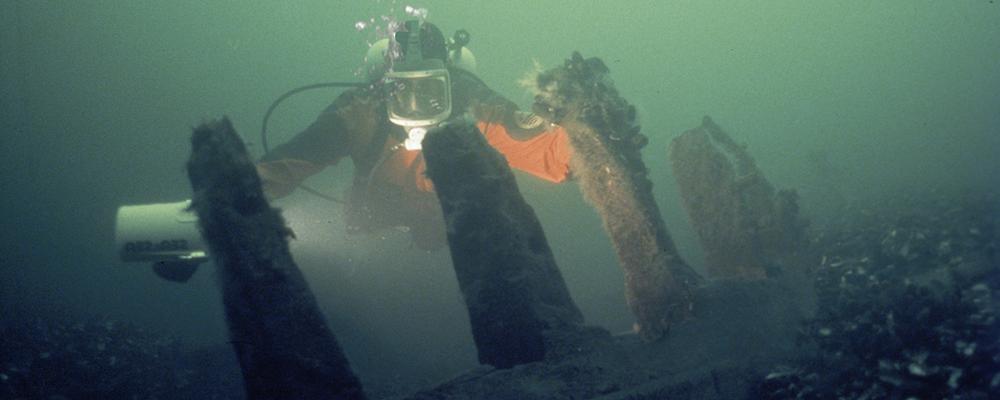
Underwater Cultural Heritage
Submerged shipwrecks are a unique part of our cultural heritage. Therefore is fundamental understanding of biological, physical, and biochemical processes that affect the shipwreck of vital importance for successful long term preservation of wooden constructions within the marine environments.
Preservation of archaeological remains under water
Together with other wooden archaeological remains, shipwrecks are incorporated in the marine carbon cycle where wood material are totally decomposed by biological, physical and biochemical processes.
Generally, wood are fast degraded by a large group of marine borers in saline waters. But in other environments such as in brackish water, fresh water and sediment, the processes are much slower and quite different. Here historical wrecks are able to survive for hundreds and even thousands of years. In the Baltic Sea, more than 20.000 well preserved wrecks and other submerged archaeological sites of historic importance is known. The warship Vasa is one of the few wrecks that has been excavated, conserved and displayed for public.
UNESCOs convention on the protection of the submerged cultural heritage stated in 2001 that shipwreck of historical significance should be preserved in-situ as a first option. Lacking economic resources for a full-scale excavation, conservation, display and maintenance are some one of the main reasons behind this recommendation.
Research focus on microbial degradation
During the last 20 years our research has focussed on the microbial degradation process. A huge number of archaeological waterlogged wood samples from marine and terrestrial environments around Europe have been studied by different microscope techniques, and decay patterns observed have been related to different types of wood degrading fungi and bacteria.
If is found that wood species, age of exposure, access to oxygen and the local environment dictates the type and degree of microbial decay. Waterlogged and near anaerobic environment promotes decay by the so-called “erosion bacteria”. These bacteria degrade wood very slowly and are not able to degrade the lignin rich parts which results in an incomplete degradation.
This explains why archaeological finds might look seemingly well preserved despite thousands of years of burial. Erosion bacteria decay are found in sediments and all type of water worldwide. Within a joint EU Bacpoles project, the bacteria were cultivated, isolated and identified by molecular biological methods (DNA) and are now believed to consist of bacteria within the Flavo and Cytophaga consortia.
Our previous EU-projects on protection of shipwreck
How climate change may affect the spread of the aggressive shipworm Teredo navalis into the Baltic was in focus in the EU WreckProtect project. Advanced GIS models were developed in order to predict the spread. The project also described and pointed out microbial degradation, water turbulence, and sediment transport as some of the key factor that will led to slow or fast degradation of wreck in a brackish environment like in the Baltic Sea. Methods for physical protection of the wreck in situ were evaluated and described. In EU SASMAP project, the work continues and tools for mapping, diagnosing, excavating and securing underwater and coastal archaeological sites are in focus. This project will end in September 2015.
In order to understand the decay processes and their interaction with the environment, long-term and short term laboratory experiments as well as field experiments is an important part of our research. With access to advanced equipped laboratory facilities as well as access to the novel research vessel, our ability to perform unique interdisciplinary and cross disciplinary research in cooperation with national and international researchers are unique.
Research Areas
- Conservation and long-term preservation of shipwreck ex-situ and in situ
- Assessment of wood decay; marine borers, state of degradation; strategies for long term monitoring of sites; methods for protection in situ; CEN/SIS standardisation related to management and assessment of waterlogged archaeological wood
- Microbial degradation of wood
- Bacterial degradation, fungal degradation. Microbial biodiversity and wood decay
- Environmental processes related to shipwreck degradation in situ
- Sedimentology, oceanography, geochemistry, biochemistry and microbial processes and interactions
- Other wood-related areas of interest:
- Foundation poles, marine poles, wood durability, terrestrial archaeological sites, storage of waterlogged wood